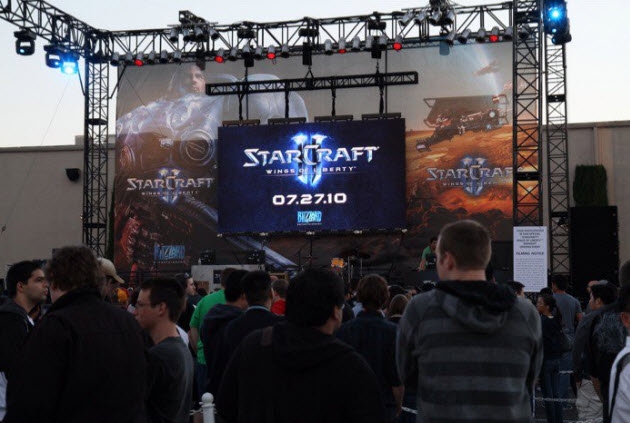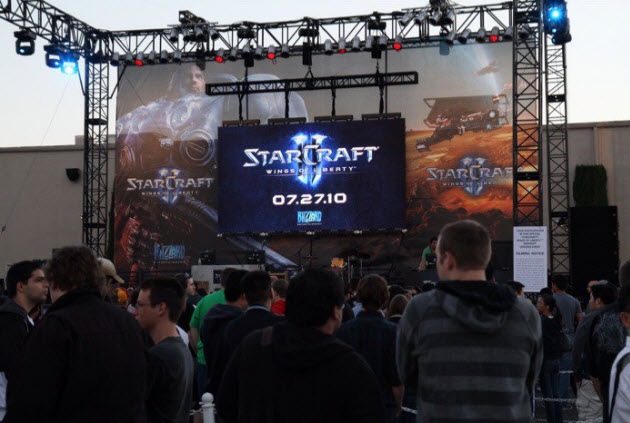
Starcraft II: Wings of Liberty went on sale tonight, some 12 years after the original game debuted. The game is likely to be one of the biggest sellers of the year and the first shot in the arm for the PC gaming market (aside from Facebook, of course) in a long time.
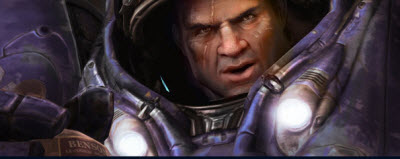 The game, which debuted with special midnight openings nationwide like the one pictured above, is expected to be both a blessing and a curse for the game industry. Other game publishers who are unlucky enough to be debuting games right now can expect their sales to vanish altogether. But the industry has been in a funk for months and game retailers will welcome a game that brings the fans out. Analyst Mike Hickey of Janco Partners estimated that Starcraft II could sell 7 million units and generate $350 million in revenues for parent firm Activision Blizzard during the current fiscal year.
The game, which debuted with special midnight openings nationwide like the one pictured above, is expected to be both a blessing and a curse for the game industry. Other game publishers who are unlucky enough to be debuting games right now can expect their sales to vanish altogether. But the industry has been in a funk for months and game retailers will welcome a game that brings the fans out. Analyst Mike Hickey of Janco Partners estimated that Starcraft II could sell 7 million units and generate $350 million in revenues for parent firm Activision Blizzard during the current fiscal year.
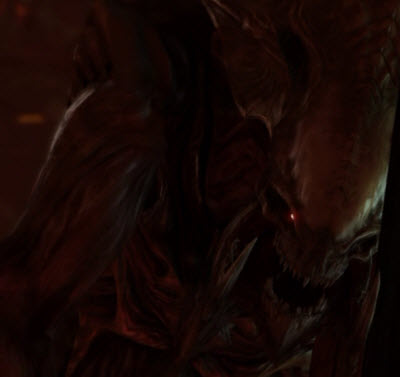 The original Starcraft was a real-time strategy game, where multiple players fight each other or the computer simultaneously, mining material and building units. There are three factions: the Terran humans, the hive-like Zerg, and the techno alien Protoss. It handled online play particularly well, and I remember many late nights playing with my friends online. Though it didn’t seem like anything special, it had staying power. In South Korea, it spawned professional gaming leagues and became a national sport. More than 11 million copies sold in the past 12 years. It was the game that wouldn’t die.
The original Starcraft was a real-time strategy game, where multiple players fight each other or the computer simultaneously, mining material and building units. There are three factions: the Terran humans, the hive-like Zerg, and the techno alien Protoss. It handled online play particularly well, and I remember many late nights playing with my friends online. Though it didn’t seem like anything special, it had staying power. In South Korea, it spawned professional gaming leagues and became a national sport. More than 11 million copies sold in the past 12 years. It was the game that wouldn’t die.
I had to laugh when I launched the new game (after signing into my Battle.net account, whose primary purpose seems to be to prevent piracy and whose secondary purpose is to enable multiplayer gaming). The main character, in a seeming reference to the making of the game, says at the very beginning, “Hell, it’s about time!” This game has a lot more storytelling in it, and from the very beginning it loads scenes that tell the story of the three warring races and the factions within them that complicate the war of extermination that is happening between them. The Zerg, for instance, are now led by Kerrigan, a Terran human hero who was captured and turned into a hive mind creature.
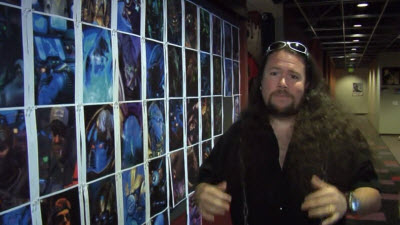 Blizzard denied a Wall Street Journal report that said it spent more than $100 million on the game (the WSJ ran a correction). Although it would be easy to spend that amount if you had 100 people working for 12 years. In fact, if you had a team that size working for that long, it could easily cost $120 million in payroll costs alone. But the team didn’t work on it for that long. They worked on games that wound up being canceled, such as Starcraft Ghost, as well as additions to World of Warcraft, which debuted in 2004 and became the most successful massively multiplayer online game of all time. I think we can stipulate that it cost a lot, though, and that the success of Blizzard’s games enabled it to take all the time that it wanted in order to make the best game possible.
Blizzard denied a Wall Street Journal report that said it spent more than $100 million on the game (the WSJ ran a correction). Although it would be easy to spend that amount if you had 100 people working for 12 years. In fact, if you had a team that size working for that long, it could easily cost $120 million in payroll costs alone. But the team didn’t work on it for that long. They worked on games that wound up being canceled, such as Starcraft Ghost, as well as additions to World of Warcraft, which debuted in 2004 and became the most successful massively multiplayer online game of all time. I think we can stipulate that it cost a lot, though, and that the success of Blizzard’s games enabled it to take all the time that it wanted in order to make the best game possible.
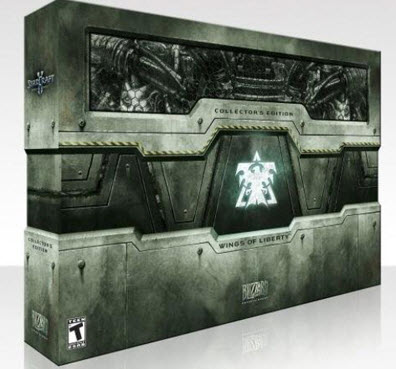 I cracked open the Collector’s Edition, which sells for about $100, compared to the $60 standard game. It comes with a lot of extras, such as a coffee table book of the game’s art, a USB drive with a dog tag from game character Jim Raynor, the soundtrack to the game, and a comic book. I liked the Behind the Scenes DVD, which features interviews with Blizzard employees about how they made the game. If you add up the value of buying all of this stuff separately, you could probably spend around $200. For a very few folks, this Collector’s Edition will be considered a bargain.
I cracked open the Collector’s Edition, which sells for about $100, compared to the $60 standard game. It comes with a lot of extras, such as a coffee table book of the game’s art, a USB drive with a dog tag from game character Jim Raynor, the soundtrack to the game, and a comic book. I liked the Behind the Scenes DVD, which features interviews with Blizzard employees about how they made the game. If you add up the value of buying all of this stuff separately, you could probably spend around $200. For a very few folks, this Collector’s Edition will be considered a bargain.
Chris Sigaty, executive producer, introduces the team that created Starcraft II, such as Sam Didier, pictured above. They talk about how they designed the game to take advantage of all the latest features in graphics cards, from shaders that change the surface of objects to advanced lighting. So gamers who have high-end computers can run the game with all of its special effects, while relatively old PCs can still run it. The box says you can play the game with a Direct X 9.0 card (a couple of generations ago), a 2.6-gigahertz microprocessor, and an ATI Radeon 9800 Pro graphics chip or Nvidia GeForce GT 6600. The game scales up or down, depending on your PC, so it can hit the widest possible audience.
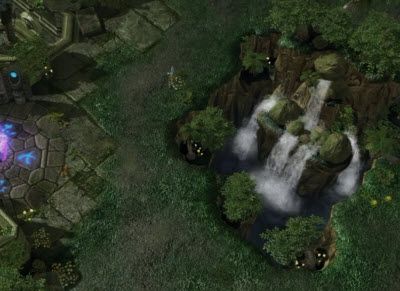 The result of the years-long effort and high-end art is a game with an incredible look. The cinematics, or animated movies that carry the story forward in between game sessions, are very well done with realistic human characters. These mini-films are compelling. I can already tell that the story of the game is going to be very compelling and its characters are going to be memorable, which is a first for a real-time strategy game where you control dozens of units on the screen at the same time.
The result of the years-long effort and high-end art is a game with an incredible look. The cinematics, or animated movies that carry the story forward in between game sessions, are very well done with realistic human characters. These mini-films are compelling. I can already tell that the story of the game is going to be very compelling and its characters are going to be memorable, which is a first for a real-time strategy game where you control dozens of units on the screen at the same time.
I’ve got the game running on a fairly powerful desktop PC, with a Fermi-based Nvidia graphics chip and a bunch of other whiz-bang features. It makes the graphics pop. I can see the cool animated characters like miniature soldiers. And each mission comes with a lot of cinematic story scenes. Of course, the proof of the pudding for this game will be multiplayer gaming on the online gaming service, Battle.net. If that works really well, then you can bet a lot of gamers will be playing this game for the rest of the year. Already, my old friends are talking about assembling some nightly battles. The last game where I played a lot with them was — the original Starcraft.
So move aside, Call of Duty Modern Warfare 2. Get out of the way, Red Dead Redemption. These are the blockbuster games of the last six months, but they’ve had their run. The Starcraft II era has begun.



